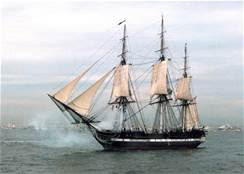~~~~~~~~~~~~~~
The predawn light reflects an eerie
blood-red from the underbellies of the incoming clouds. As the light
penetrates the canopy, the last of the nocturnal creatures have returned to
their refuge to wait out the coming light. High in the crown of a mighty
oak, pacing with anticipation of the coming daylight, a roosted tom turkey
shakes the forest awake with his gobble. The incoming weather begins to
sway the uppermost branches of the tallest trees, delicately blending with the
last calls of the whippoorwill.
Splaying at the feet of a seemingly
endless sea of tree trunks are an array of wildflowers, too numerous to count,
filling the morning air with the sweet smell of spring. The babbling
creek, meandering through the valley, flows as a reminder of the water that
formed this landscape over millions of years from an ancient seabed. As
the distant thunder rolls, the forest community continues inexorably on, a
resilient yet delicate system on which the entire world depends for so much.
Is it any wonder why the stewardship
of these natural treasures is a very delicate issue? Forests were often seen as
an obstacle to taming the wild lands. Others have seen the forests as a
resource meant solely to serve the desires of mankind. Still others have
seen the forests as a sacred place, harboring delicate systems that should not
be disturbed. Wherever the truth resides, the foresters charged with
managing such lands have a difficult task keeping the balance between
maintaining a viable ecosystem, providing resources, and balancing public
perception.
Naval Support Activity Crane’s more than 50,000 acres of forest have been sustainably
managed for more than six decades. This forest provides some of the richest
biodiversity in all of Indiana while also providing valuable resources to the
local economy. Trees in the Midwest are typically regenerated naturally rather
than planted. The forest regenerates much more efficiently than many realize.
After all, it wasn’t long after the industrial revolution that most of the
forests of the eastern U.S. were cleared to provide material for a growing
country and they still made a triumphant return. Railroads, homes, tools,
fuel-wood, charcoal, and countless other uses . . .
These seemingly endless forest
resources built this young country and took it from a few wayward colonies that
declared their independence just a few decades earlier to the most powerful
nation the world has ever known. A nation with the most powerful Navy the world
has ever known. And even it owes its beginnings to this same wood.
Knowing the young country couldn’t
compete with the sheer number of vessels of countries like France or England,
Joshua Humphries wanted the most advanced Navy ships on the seas. Capable of
battling against the Barbary pirates of North Africa to protect this fledgling
nation’s merchant ships while also defending against a possible invasion. Live
oak for the internal frame of the ship to ensure strength and longevity. White
oak to form the hull planks for the sturdy water-tight seal that would keep the
ships afloat. And of these original six wooden frigates that started our great
Navy, which even today remains most advanced in the world, one wooden frigate
still floats. A commissioned warship that still hosts a crew of approximately
70 Sailors, the USS Constitution still floats in the Charlestown Navy yard
across the bay from Boston Massachusetts. Old Ironsides. Gaining the nickname
during the war of 1812 while defending the new nation from just such an
invasion as the early Navy pioneers had feared.
And while the landscape and
available forests surrounding the Boston area has diminished, the Navy is still
able to provide much of the material for this world’s-oldest commissioned
warship still afloat. The forests of NSA Crane host century-old white oak trees
throughout the hills and valleys, providing the logs that are formed into
planks for the sturdy hull. Even stands of middle-aged white oak, 70 to 80
years old, are set aside for future restoration efforts of this mighty
ship. The management goals of this forest fit perfectly with the ability
to provide large white oak trees for this great, heritage rich, cause. Every
tree that is harvested from Crane’s forests, whatever the reason, is carefully
selected by one of the three foresters on station to ensure the forest is able
to maintain its legacy of beauty and productivity. Large areas are set
aside to ensure old-growth forests still remain. Wildlife is protected to
ensure a healthy, intact, and diverse ecosystem will always remain.
~~~~~~~~~~~~~~~~~~~~~~~~~
With Constitution having just completed a two year overhaul, it is appropriate that we offer the above piece at this time, as many of her timbers were replaced with Live Oak harvested from both Crane's forests as well as some in the South. It is also interesting to note that White Oak windfalls from storms are preserved and protected for our Ship of State.
Until next time (and it won't be as long!),
Fair Winds,
Old Salt





No comments:
Post a Comment